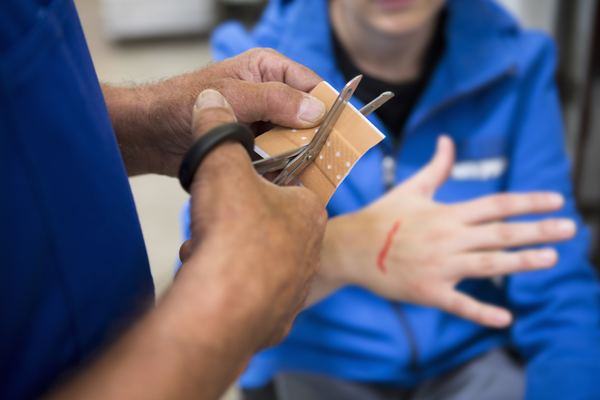In business for over 80 years AccuformNMC is the leading manufacturer of American made safety communication products—including over 16,000 safety signs, tags, and labels. Our commitment is to support every safety ID need, with the best product, service and custom solutions in the industry. We offer the toughest signs and labels in the market, and guarantee them for life. Protected with Sign Muscle®, a clear liquid over-laminate strong enough to protect against fading under direct sunlight, it allows easy graffiti removal, resists chemical corrosion and is applied for free.
OSHA Injury Reporting Form 301

Has an employee ever been injured at your business? What was the first thing you did after helping them? Employers should keep form 301, otherwise known as the OSHA injury reporting form, in the back of their mind as they respond to worksite injuries.
Accidents happen in the workplace and they can't go unnoticed. OSHA depends on employers to report accidents when they occur so they can keep track of valuable statistics that key the organization in on whether initiatives, regulations and sanctions are doing their part.
Regardless of whether the employee is injured or falls ill due to work, it must be recorded and sent to OSHA. That's where injury forms come in.
What is form 301?
Form 301 came into existence January 1, 2005, and took the place of form 101. According to OSHA, the injury reporting form must be filled out within seven days of acknowledging an employee is injured or has fallen ill on the job. This could be anything from a machine-guarding accident where an employee scrapes his or her elbow, to a chemical spill that requires multiple hospitalizations.
OSHA allows for substitute forms that often go to insurance to be filled out in place of the injury reporting form, but the replacement must contain all of the information being asked for in OSHA's form.
Employers must keep this report on record for at least 5 years, OSHA reported. This is to keep in accordance with Public Law 91-596 and 29 CFR 1904. Basically, these laws cover the requirements of providing a hazard-free work environment and reporting accidents when they do happen.
What information do you need to know?
The important thing to know about reporting an injury is that it doesn't mean the employer is at fault, or that a regulation has been violated. Filling out the OSHA injury reporting form is simply performing due diligence.
- The first portion of the form requires the employer to fill out basic personal information pertaining to the employee. Question No. 1 through 9 should be either first-hand knowledge or come from employee records.
- Question No. 10 requires the case number from form 300 while No. 11 through 13 asks basic questions, such as when the employee started their shift.
- The rest of the questions on the form ask for information pertaining to the injury. What happened? What objects and machines were involved? Employers should review surveillance footage if available and corroborate stories with employees. The information needs to be as accurate as possible – not to get anyone in trouble with the law, but to make sure OSHA fully understands what happened.
OSHA estimates the form should only take around 22 minutes to fill out. This includes research and answering questions. The OSHA injury reporting form takes little time to fill out and provides help to the organization as it tries to tackle accidents that are difficult to anticipate in the work setting. The end goal of this process is to provide a safer work environment for the future by learning from the past.
Previously featured on National Marker Company.
Brought To You By
.png?itok=k2IwFSM2)
More from AccuformNMC
More on Training
Forklifts and other powered industrial trucks (PITs) help workers accomplish many tasks in manufacturing, but they also pose a risk of serious accidents. Follow these training requirements to keep your people safe.
Learn how technology can aid worker safety in your organization.
What are the challenges to meeting OSHA standards during the COVID-19 pandemic? MSA Safety offers virtual trainng sessions to help meet these requirements.






Talk to Us!
Leave a reply
Your email address will not be published. Required fields are marked *